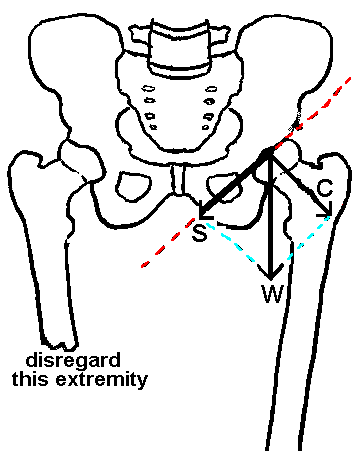
We begin by drawing a red, dashed reference line that approximates the hip joint surface's orientation. The surface is curved, so we estimate the orientation of a line that is tangent to that curve.

| Vector W represents the force of gravity acting on the body mass that is superincumbent to the hip joint. To analyze vector W's effect at the joint surface, we have translated it through space until its point of application lies on the reference line. The vector's exact placement on the reference line is unimportant as long as we neither "tip" (angulate) the vector nor change its magnitude (length) during the translation. Of course, once we move the vector from its original location, we can no longer use it to measure moment arms, but that is not our purpose. |
|---|
Instead, our purpose is to understand how gravity's force affects the joint surface. To accomplish this, we resolve gravity's force into two component forces, both of which act at right angles to one another:
It takes some practice to learn how long to draw the component vectors. The finished product should look like the figure, with the component vectors drawn just long enough so the original vector is actually their resultant. (Vector resolution is a reciprocal operation to vector composition, much like division is a reciprocal arithmetic operation to multiplication.)
The same analysis clarifies the effects on the hip joint surface of the abductor muscles.